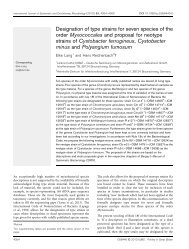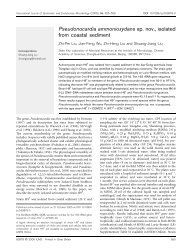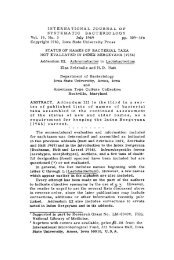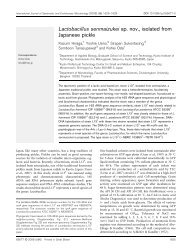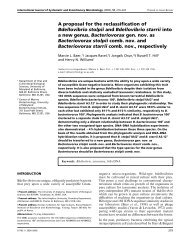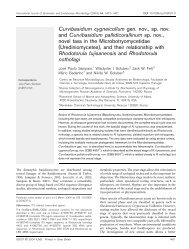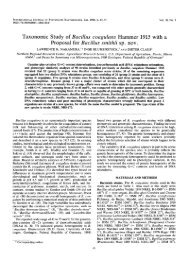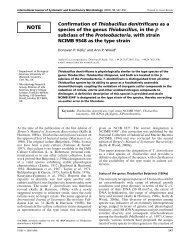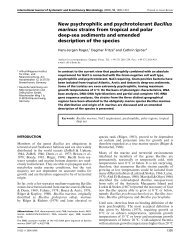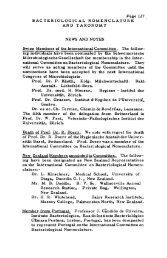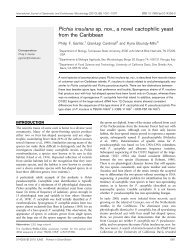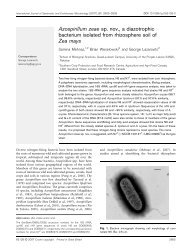Desulfopila inferna sp. nov., a sulfate-reducing bacterium isolated ...
Desulfopila inferna sp. nov., a sulfate-reducing bacterium isolated ...
Desulfopila inferna sp. nov., a sulfate-reducing bacterium isolated ...
You also want an ePaper? Increase the reach of your titles
YUMPU automatically turns print PDFs into web optimized ePapers that Google loves.
International Journal of Systematic and Evolutionary Microbiology (2010), 60, 1626–1630<br />
DOI 10.1099/ijs.0.015644-0<br />
<strong>Desulfopila</strong> <strong>inferna</strong> <strong>sp</strong>. <strong>nov</strong>., a <strong>sulfate</strong>-<strong>reducing</strong><br />
<strong>bacterium</strong> <strong>isolated</strong> from the subsurface of a tidal<br />
sand-flat<br />
Antje Gittel, 1 3 Michael Seidel, 1 Jan Kuever, 2 Alexander S. Galushko, 3<br />
Heribert Cypionka 1 and Martin Könneke 1<br />
Corre<strong>sp</strong>ondence<br />
Antje Gittel<br />
antje.gittel@biology.au.dk<br />
1 Institut für Chemie und Biologie des Meeres, Universität Oldenburg, Carl von Ossietzky-Strasse<br />
9–11, Postfach 2503, D-26111 Oldenburg, Germany<br />
2 Bremen Institute for Materials Testing, Paul-Feller-Strasse 1, D-28199 Bremen, Germany<br />
3 Max Planck Institute for Marine Microbiology, Celsiusstrasse 1, D-28359 Bremen, Germany<br />
A Gram-negative, rod-shaped, <strong>sulfate</strong>-<strong>reducing</strong> <strong>bacterium</strong> (strain JS_SRB250Lac T ) was <strong>isolated</strong><br />
from a tidal sand-flat in the German Wadden Sea. 16S rRNA gene sequence analysis showed<br />
that strain JS_SRB250Lac T belonged to the Desulfobulbaceae (Deltaproteobacteria), with<br />
<strong>Desulfopila</strong> aestuarii MSL86 T being the closest recognized relative (94.2 % similarity). Higher<br />
similarity (96.6 %) was shared with ‘Desulfo<strong>bacterium</strong> corrodens’ IS4, but this name has not been<br />
validly published. The affiliation of strain JS_SRB250Lac T to the genus <strong>Desulfopila</strong> was further<br />
supported by analysis of aprBA gene sequences and shared physiological characteristics, in<br />
particular the broad range of organic electron donors used for <strong>sulfate</strong> reduction. Compared with<br />
<strong>Desulfopila</strong> aestuarii MSL86 T , strain JS_SRB250Lac T additionally utilized butyrate and succinate<br />
and grew chemolithoautotrophically with hydrogen as an electron donor. CO dehydrogenase<br />
activity was demonstrated, indicating that the reductive acetyl-CoA pathway (Wood–Ljungdahl<br />
pathway) was used for CO 2 fixation. Results of cellular fatty acid analysis allowed<br />
chemotaxonomic differentiation of strain JS_SRB250Lac T from <strong>Desulfopila</strong> aestuarii MSL86 T by<br />
the presence of C 17 : 0 cyclo and the absence of hydroxy and unsaturated branched-chain fatty<br />
acids. Based on phylogenetic, physiological and chemotaxonomic characteristics, strain<br />
JS_SRB250Lac T represents a <strong>nov</strong>el <strong>sp</strong>ecies of the genus <strong>Desulfopila</strong>, for which the name<br />
<strong>Desulfopila</strong> <strong>inferna</strong> <strong>sp</strong>. <strong>nov</strong>. is proposed. The type strain is JS_SRB250Lac T (5DSM 19738 T<br />
5NBRC 103921 T ).<br />
Sandy surface sediments of tidal flats in the Wadden Sea<br />
are densely populated by micro-organisms and characterized<br />
by high remineralization rates (Ishii et al., 2004; de<br />
Beer et al., 2005; Billerbeck et al., 2006b; Musat et al.,<br />
2006). Due to their high permeability, seawater drains into<br />
the sediment and organic matter is filtered and enriched in<br />
3Present address: Department of Biological Sciences, Microbiology,<br />
Aarhus University, Ny Munkegade 114, DK-8000 Aarhus C, Denmark.<br />
Abbreviation: SRB, <strong>sulfate</strong>-<strong>reducing</strong> bacteria.<br />
The GenBank/EMBL/DDBJ accession numbers for the nucleotide<br />
sequences reported in this study are AM774321, FJ548990 and<br />
FJ548989 (16S rRNA, dsrAB and aprBA gene sequences, re<strong>sp</strong>ectively,<br />
of strain JS_SRB250Lac T ) and FJ548988 (aprBA gene sequence of<br />
<strong>Desulfopila</strong> aestuarii MSL86 T ).<br />
A phase-contrast micrograph of cells of strain JS_SRB250Lac T and<br />
maximum-likelihood trees based on DsrAB and AprBA amino acid<br />
sequences are available as supplementary material with the online<br />
version of this paper.<br />
the sediment surface, fuelling microbial activity (Huettel &<br />
Rusch, 2000; D’Andrea et al., 2002). In addition, porewater<br />
can be tran<strong>sp</strong>orted down several metres to deep<br />
sediments by a tide-driven hydraulic pressure gradient and<br />
provide microbial communities at these depths with<br />
utilizable substrates (Billerbeck et al., 2006a; Røy et al.,<br />
2008). This phenomenon was recently supported by the<br />
demonstration of large total prokaryotic cell numbers and<br />
the presence of a highly abundant and potentially active<br />
community of <strong>sulfate</strong>-<strong>reducing</strong> bacteria (SRB) at a depth of<br />
several metres of a tidal sand-flat (‘Janssand’, German<br />
Wadden Sea; Gittel et al., 2008). In the course of this<br />
investigation, strain JS_SRB250Lac T and four closely<br />
related strains were <strong>isolated</strong> from highly diluted sediment<br />
samples from different depths and identified as forming a<br />
distinct cluster within the Desulfobulbaceae (Gittel et al.,<br />
2008). It was furthermore confirmed by in situ quantification<br />
(CARD-FISH; catalysed reporter deposition–<br />
fluorescence in situ hybridization) that members of the<br />
1626 015644 G 2010 IUMS Printed in Great Britain
<strong>Desulfopila</strong> <strong>inferna</strong> <strong>sp</strong>. <strong>nov</strong>.<br />
Desulfobulbaceae and the Desulfobacteraceae dominated the<br />
<strong>sulfate</strong>-<strong>reducing</strong> community. Therefore, the newly <strong>isolated</strong><br />
strains appeared to be representative of an in situ abundant<br />
and active fraction of SRB. The five <strong>isolated</strong> strains<br />
exhibited less than 95 % 16S rRNA gene sequence identity<br />
to the closest relative with a validly published name,<br />
<strong>Desulfopila</strong> aestuarii MSL86 T (Suzuki et al., 2007), but<br />
more than 96 % 16S rRNA gene sequence identity was<br />
shared with the marine <strong>sulfate</strong> reducer ‘Desulfo<strong>bacterium</strong><br />
corrodens’ IS4 (Dinh et al., 2004). The latter strain has not<br />
yet been described taxonomically. Strain JS_SRB250Lac T<br />
was subjected to a phylogenetic, physiological and<br />
chemotaxonomic characterization and comparison with<br />
‘Desulfo<strong>bacterium</strong> corrodens’ IS4 and <strong>Desulfopila</strong> aestuarii<br />
MSL86 T .<br />
Strain JS_SRB250Lac T was <strong>isolated</strong> from sediment at a<br />
depth of 2.5 m from a tidal sand-flat in the German<br />
Wadden Sea (‘Janssand’; 53u 44.1779 N 007u 41.9709 E).<br />
Details of the sampling site have been described elsewhere<br />
(Beck et al., 2007; Røy et al., 2008). Enrichment and<br />
isolation of strain JS_SRB250Lac T were described previously<br />
(Gittel et al., 2008). <strong>Desulfopila</strong> aestuarii MSL86 T<br />
was kindly provided by Katsuji Ueki (Yamagata University,<br />
Japan). A culture of ‘Desulfo<strong>bacterium</strong> corrodens’ IS4 was<br />
provided by Dennis Enning (Max Planck Institute for<br />
Marine Microbiology, Bremen, Germany).<br />
Cultivation, growth experiments and strain maintenance<br />
were performed in an anoxic, carbonate-buffered, mineral<br />
medium as described previously (Gittel et al., 2008). Unless<br />
otherwise noted, incubations were carried out with an<br />
inoculum volume of 5 % (v/v) and at 20 uC in the dark.<br />
Gram-staining of heat-fixed cells was carried out as<br />
described by Murray et al. (1994). Cells of strain<br />
JS_SRB250Lac T were Gram-negative, non-motile, straight<br />
rods with rounded ends, 0.3–0.5 mm wide and 1.0–2.0 mm<br />
long (Supplementary Fig. S1, available in IJSEM Online).<br />
Longer cells, up to 5 mm, developed at low temperatures<br />
(,15 uC). Cells of strain JS_SRB250Lac T formed lightbrown<br />
colonies in agar tubes and aggregated during growth<br />
in liquid medium. Formation of endo<strong>sp</strong>ores was not<br />
observed.<br />
Growth experiments were performed in triplicate and<br />
monitored by phase-contrast microscopy combined with<br />
photometric sulfide measurement (Cord-Ruwisch, 1985)<br />
and/or by the determination of cellular protein content<br />
(Bradford, 1976). Growth rates were calculated from linear<br />
regression of cellular protein as a function of time. The<br />
effect of NaCl concentration on growth was determined in<br />
mineral medium with NaCl concentrations between 1 and<br />
50 g l 21 . Highest growth rates were observed at NaCl<br />
concentrations between 20 and 30 g l 21 . Growth did<br />
not occur at NaCl concentrations below 5 g l 21 . The<br />
temperature range for growth was determined in seawater<br />
medium (28 g NaCl l 21 ) and incubation at 4–50 uC.<br />
Growth was observed between 10 and 35 uC, with highest<br />
growth rates at 28 uC.<br />
Various organic acids, alcohols, amino acids and aromatic<br />
compounds and hydrogen were tested as electron donors for<br />
<strong>sulfate</strong> reduction. Organic substrates were added from sterile<br />
stock solutions at final concentrations between 2 and<br />
10 mM. Lactate and acetate were quantified with an<br />
HPLC system equipped with an Aminex HPX-87H ionexclusion<br />
column (Bio-Rad) and analysed at 60 uC, with<br />
5mM H 2 SO 4 as the mobile phase and UV detection at<br />
210 nm (UVIS 204; Linear Instruments Corp.). Strain<br />
JS_SRB250Lac T utilized a variety of organic substrates<br />
including fatty acids and alcohols (Table 1; detailed<br />
information is given in the <strong>sp</strong>ecies description). Besides<br />
sharing a broad range of substrates with <strong>Desulfopila</strong> aestuarii<br />
MSL86 T , strain JS_SRB250Lac T also utilized hydrogen,<br />
butyrate and succinate as electron donors. Lactate was<br />
oxidized incompletely to acetate. This was a common<br />
feature of strain JS_SRB250Lac T and its closest relatives,<br />
<strong>Desulfopila</strong> aestuarii and ‘Desulfo<strong>bacterium</strong> corrodens’, but<br />
the calculation of growth rates at optimum temperatures<br />
and NaCl concentrations for each strain highlighted that<br />
<strong>Desulfopila</strong> aestuarii MSL86 T grew ten times faster (Suzuki<br />
et al., 2007) than strain JS_SRB250Lac T (maximum growth<br />
rate 0.198 day 21 ) and ‘Desulfo<strong>bacterium</strong> corrodens’ IS4, with<br />
a doubling time of 3–4 days (Dinh et al., 2004).<br />
Lithoautotrophic growth was tested by repeated transfers<br />
into a medium that was free of organic electron donors and<br />
overlaid with a head<strong>sp</strong>ace of H 2 /CO 2 (90 : 10, v/v).<br />
Measurement of enzyme activities (CO dehydrogenase, 2-<br />
oxoglutarate : electron acceptor oxidoreductase) was done<br />
Table 1. Selected characteristics for differentiation of strain<br />
JS_SRB250Lac T from related strains<br />
Strains: 1, JS_SRB250Lac T ;2,‘Desulfo<strong>bacterium</strong> corrodens’ IS4 (data<br />
from Dinh, 2003; Dinh et al., 2004); 3, <strong>Desulfopila</strong> aestuarii MSL86 T<br />
(Suzuki et al., 2007). All strains formed rod-shaped cells and were<br />
positive for utilization of lactate and pyruvate as electron donors for<br />
<strong>sulfate</strong> reduction and fermentation of pyruvate in the absence of<br />
<strong>sulfate</strong>. All strains were negative for utilization of propionate, malate<br />
and alanine as electron donors for <strong>sulfate</strong> reduction and fermentation<br />
of lactate and malate.<br />
Characteristic 1 2 3<br />
DNA G+C content (mol%) 50.3 51.9 54.5<br />
Optimum salinity (% NaCl, w/v) 2–3 1–1.5 1<br />
Optimum temperature (uC) 28 28–30 35<br />
Utilization of electron donors (final<br />
concentration, mM)<br />
H 2 + + 2<br />
H 2 plus acetate (2) + + 2<br />
n-Butyrate (5) + 2 2<br />
Fumarate (10) + 2 +<br />
Succinate (10) + 2 2<br />
Utilization of electron acceptors (final<br />
concentration, mM)<br />
Thio<strong>sulfate</strong> (10) 2 2 +<br />
http://ijs.sgmjournals.org 1627
A. Gittel and others<br />
as described previously (Galushko & Schink, 2000; Kuever<br />
et al., 2001). Strain JS_SRB250Lac T utilized hydrogen<br />
as an electron donor and carbon dioxide/bicarbonate<br />
as sole carbon sources. In a cell-free extract of strain<br />
JS_SRB250Lac T , active CO dehydrogenase was found<br />
[205 nmol (mg protein 21 ) min 21 ], whereas 2-oxoglutarate<br />
: electron acceptor oxidoreductase (a key enzyme in the<br />
citric acid cycle) was not detected. This indicated the<br />
operation of the reductive acetyl-CoA pathway (Wood–<br />
Ljungdahl pathway) for CO 2 fixation (Thauer, 1988).<br />
Growth in <strong>sulfate</strong>-free medium with lactate (20 mM) as<br />
electron donor was observed with sulfite (2 mM) as an<br />
electron acceptor, but not with nitrate (5 mM) or<br />
thio<strong>sulfate</strong> (10 mM). Fermentative growth occurred with<br />
pyruvate and fumarate, but not with lactate or malate<br />
(10 mM each).<br />
‘Desulfo<strong>bacterium</strong> corrodens’ IS4 and JS_SRB250Lac T were<br />
phylogenetically more closely related than were <strong>Desulfopila</strong><br />
aestuarii MSL86 T and JS_SRB250Lac T , but they clearly<br />
differed with re<strong>sp</strong>ect to their physiological properties.<br />
The strains originated from either surface or subsurface<br />
sediments and the lower salinity optimum of ‘Desulfo<strong>bacterium</strong><br />
corrodens’ IS4 (1.0–1.5 %) might be inferred from<br />
its exposure to fresh water in surface sediments. Beside its<br />
striking ability to oxidize elemental iron anaerobically,<br />
‘Desulfo<strong>bacterium</strong> corrodens’ IS4 was shown to utilize only<br />
a few other electron donors, e.g. lactate and pyruvate.<br />
Cultivation with these alternative electron donors yielded<br />
only poor growth compared with the utilization of elemental<br />
iron (Dinh et al., 2004). In contrast, strain JS_SRB250Lac T<br />
was nutritionally versatile, utilizing a variety of short-chain<br />
organic acids and alcohols as well as hydrogen as electron<br />
donors, but did not utilize elemental iron as an electron<br />
donor (Dennis Enning, personal communication).<br />
For cellular fatty acid analysis, cells of strain JS_SRB250Lac T<br />
and ‘Desulfo<strong>bacterium</strong> corrodens’ IS4 were grown with<br />
lactate (20 mM) and <strong>sulfate</strong> (28 mM) and harvested from<br />
the late exponential phase by centrifugation. Fatty acid<br />
methyl esters were obtained by saponification, methylation<br />
and extraction (Sasser, 1997). Positions of double bonds in<br />
fatty acid methyl esters were determined by analysis of their<br />
dimethyl disulfide (DMDS) adducts according to the<br />
method of Dunkelblum et al. (1985). Fatty acid methyl<br />
esters were quantified via GC-FID (Hewlett Packard HP<br />
5890 Series II gas chromatograph). The major cellular fatty<br />
acids of strain JS_SRB250Lac T were C 16 : 0 ,C 18 : 0 ,C 16 : 1 v7,<br />
C 16 : 1 v5 and C 17 : 0 cyclo. Significant differences in the<br />
cellular fatty acid profiles of strains JS_SRB250Lac T and<br />
‘Desulfo<strong>bacterium</strong> corrodens’ IS4 compared with the profile<br />
of <strong>Desulfopila</strong> aestuarii MSL86 T were the presence and large<br />
relative amounts of the cyclopropane fatty acid C 17 : 0 cyclo<br />
(15.3 and 22.5 %, re<strong>sp</strong>ectively) and the absence of hydroxy<br />
and unsaturated branched-chain fatty acids in the former<br />
strains (Table 2).<br />
The G+C content of the genomic DNA was determined by<br />
means of HPLC at the Identification Service of the DSMZ<br />
Table 2. Cellular fatty acid compositions of strain<br />
JS_SRB250Lac T and related strains<br />
Strains: 1, JS_SRB250Lac T ;2,‘Desulfo<strong>bacterium</strong> corrodens’ IS4 (data<br />
from this study); 3, <strong>Desulfopila</strong> aestuarii MSL86 T (data from Suzuki<br />
et al., 2007). Values are percentages by weight of total fatty acids; 2,<br />
not detected/not reported.<br />
Fatty acid 1 2 3<br />
Saturated straight-chain<br />
C 14 : 0 1.1 1.2 1.4<br />
C 15 : 0 1.6 1.3 2<br />
C 16 : 0 23.3 15.6 33.6<br />
C 17 : 0 8.3 5.9 3.4<br />
C 18 : 0 11.5 3.9 2.5<br />
Unsaturated straight-chain<br />
C 15 : 1 v6 2 1.2 1.1<br />
C 16 : 1 v9 0.7 2 2<br />
C 16 : 1 v7 18.3 11.1 6.0<br />
C 16 : 1 v5 11.4 21.9 17.1<br />
C 17 : 1 v6 2 1.6 13.7<br />
C 18 : 1 v7 8.6 7.6 1.7<br />
C 18 : 1 v5 2 3.9 2.7<br />
Cyclic fatty acids<br />
C 17 : 0 cyclo 15.3 22.5 2<br />
Hydroxy fatty acids 2 2 4.5<br />
Unsaturated branched-chain fatty acids 2 2 4.6<br />
(Braunschweig, Germany). Nucleic acid extraction, amplification,<br />
cloning and sequencing of the 16S rRNA gene of<br />
JS_SRB250Lac T were performed as described previously<br />
(Gittel et al., 2008). Phylogenetic trees based on 16S rRNA<br />
gene sequence datasets (.1400 nt) were constructed using<br />
the neighbour-joining and maximum-likelihood algorithms<br />
implemented in the ARB program package (Ludwig<br />
et al., 2004). In addition, a fragment containing approx.<br />
1.9 kb of the dsrAB gene (encoding the a- and b-subunits<br />
of the dissimilatory sulfite reductase) was amplified, cloned<br />
and sequenced according to Kjeldsen et al. (2007). A<br />
custom-designed internal primer (59-GTGCCTTTGATC-<br />
TGCAG-39) was used to complete the sequence. aprBA<br />
genes (encoding the adenosine-59-pho<strong>sp</strong>ho<strong>sulfate</strong> reductase<br />
a- and b-subunits) of strain JS_SRB250Lac T and<br />
<strong>Desulfopila</strong> aestuarii MSL86 T were determined using two<br />
sets of degenerate primers (AprB-1-FW/AprA-5-RV and<br />
AprA-1-FW/Apr-10-RV) as described previously (Meyer &<br />
Kuever, 2007). DsrAB and AprBA amino acid sequencebased<br />
phylogenetic trees were inferred using the PhyML<br />
program (maximum-likelihood method; http://www.<br />
atgc-montpellier.fr/phyml/). Datasets (deduced from dsrAB<br />
and aprBA gene sequences) including all available unambiguously<br />
aligned DsrAB and AprBA amino acid sequence<br />
positions of members of the family Desulfobulbaceae were<br />
analysed. Maximum-likelihood trees were constructed using<br />
the WAG amino acid substitution model matrices. The<br />
robustness of inferred trees was tested by bootstrap analysis<br />
with 1000 (16S rRNA gene) and 100 (DsrAB, AprBA)<br />
resamplings.<br />
1628 International Journal of Systematic and Evolutionary Microbiology 60
<strong>Desulfopila</strong> <strong>inferna</strong> <strong>sp</strong>. <strong>nov</strong>.<br />
Phylogenetic analyses of 16S rRNA gene sequence datasets<br />
showed that strain JS_SRB250Lac T is grouped within the<br />
deltaproteobacterial family Desulfobulbaceae (Fig. 1).<br />
‘Desulfo<strong>bacterium</strong> corrodens’ IS4, <strong>isolated</strong> from marine<br />
sediment, was identified as the closest cultured relative of<br />
strain JS_SRB250Lac T , sharing 96.6 % 16S rRNA gene<br />
sequence similarity (Dinh et al., 2004), but this name<br />
has not been validly published. The closest relative of<br />
strain JS_SRB250Lac T with a validly published name was<br />
<strong>Desulfopila</strong> aestuarii MSL86 T (94.2 % similarity), which was<br />
<strong>isolated</strong> from an estuarine sediment in Japan (Suzuki et al.,<br />
2007). The affiliation of strain JS_SRB250Lac T to the<br />
Desulfobulbaceae was confirmed by DsrAB and AprBA<br />
amino acid sequence analyses (Supplementary Fig. S2).<br />
AprBA amino acid sequence analyses additionally supported<br />
its close relationship to ‘Desulfo<strong>bacterium</strong> corrodens’ DSM<br />
15630 (5IS4) (94 % identity) and <strong>Desulfopila</strong> aestuarii<br />
MSL86 T (90 % identity). dsrAB gene sequences for<br />
<strong>Desulfopila</strong> aestuarii MSL86 T (Katsuji Ueki, personal<br />
communication) and ‘Desulfo<strong>bacterium</strong> corrodens’ IS4 (this<br />
study) could not be determined with the standard procedure<br />
and primer variations as described by Loy et al. (2002).<br />
Based on the phylogenetic, physiological and chemotaxonomic<br />
characteristics described above, strain JS_SRB250Lac T<br />
should be classified as a member of the genus <strong>Desulfopila</strong> and<br />
we propose that it represents a <strong>nov</strong>el <strong>sp</strong>ecies, <strong>Desulfopila</strong><br />
<strong>inferna</strong> <strong>sp</strong>. <strong>nov</strong>.<br />
Description of <strong>Desulfopila</strong> <strong>inferna</strong> <strong>sp</strong>. <strong>nov</strong>.<br />
<strong>Desulfopila</strong> <strong>inferna</strong> (in.fer9na. L. fem. adj. <strong>inferna</strong> that<br />
which is, or comes from, below, referring to the isolation of<br />
the type strain from a subsurface sediment).<br />
Cells are straight rods with rounded ends, 0.3–0.5 mm wide<br />
and 1.0–2.0 mm long. Non-motile. The NaCl range for<br />
growth is 0.5–5 % (w/v) with an optimum between 2 and<br />
3 % (w/v). The temperature range for growth is 10–35 uC<br />
with an optimum at 28 uC. Utilizes formate, n-butyrate,<br />
lactate, fumarate, pyruvate, succinate, valerate, caproate,<br />
caprate, ethanol, 1-propanol, 1-butanol, glycerol and<br />
proline as electron donors for <strong>sulfate</strong> reduction.<br />
Chemolithoautotrophic growth with H 2 plus CO 2 /bicarbonate.<br />
Does not utilize acetate, propionate, malate,<br />
glycine, alanine, serine, betaine, choline, benzoate, sorbitol<br />
or mannitol. Sulfate and sulfite serve as electron acceptors.<br />
Thio<strong>sulfate</strong> and nitrate are not utilized. Pyruvate and<br />
fumarate are fermented in the absence of electron<br />
acceptors. Malate and lactate are not fermented. The<br />
genomic DNA G+C content of the type strain is<br />
50.3 mol%. The major cellular fatty acids are C 16 : 0 ,<br />
C 18 : 0 ,C 16 : 1 v7, C 16 : 1 v5 and C 17 : 0 cyclo.<br />
The type strain is JS_SRB250Lac T (5DSM 19738 T 5NBRC<br />
103921 T ), <strong>isolated</strong> from subsurface sediment from a tidal<br />
sand-flat of the German Wadden Sea.<br />
Acknowledgements<br />
The authors are grateful to Michael Pilzen and Katharina Deutz for<br />
their help in analytical procedures. We thank Jürgen Rullkötter for<br />
providing facilities to analyse fatty acid methyl esters. Dennis Enning<br />
(Max Planck Institute for Marine Microbiology, Bremen, Germany)<br />
is acknowledged for testing JS_SRB250Lac T for its capacity for<br />
anaerobic iron oxidation. We thank Ramona Appel (Max Planck<br />
Institute for Marine Microbiology, Bremen, Germany) for HPLC<br />
analysis of fatty acids. Special thanks go to Nina Schomacker and<br />
Markko Remesch for their help in obtaining the APS reductase gene<br />
sequences. This work was supported financially by a grant from the<br />
Fig. 1. Neighbour-joining tree showing the affiliation of the 16S rRNA gene sequence of strain JS_SRB250Lac T to selected<br />
reference sequences from members of the Deltaproteobacteria. Bootstrap values are percentages based on analysis of 1000<br />
replicates; only values .50 % are indicated near nodes. The tree topology inferred from maximum-likelihood analysis was similar<br />
to that obtained from the neighbour-joining method (not shown). Bar, 10 % sequence divergence.<br />
http://ijs.sgmjournals.org 1629
A. Gittel and others<br />
Deutsche Forschungsgemeinschaft (FOR432, ‘Biogeochemistry of<br />
tidal flats’).<br />
References<br />
Beck, M., Dellwig, O., Kolditz, K., Freund, H., Liebezeit, G.,<br />
Schnetger, B. & Brumsack, H.-J. (2007). In situ pore water sampling<br />
in deep intertidal flat sediments. Limnol Oceanogr Methods 5, 136–<br />
144.<br />
Billerbeck, M., Werner, U., Bosselmann, K., Walpersdorf, E. &<br />
Huettel, M. (2006a). Nutrient release from an exposed intertidal sand<br />
flat. Mar Ecol Prog Ser 316, 35–51.<br />
Billerbeck, M., Werner, U., Polerecky, L., Walpersdorf, E., de Beer, D.<br />
& Huettel, M. (2006b). Surficial and deep pore water circulation<br />
governs <strong>sp</strong>atial and temporal scales of nutrient recycling in intertidal<br />
sand flat sediment. Mar Ecol Prog Ser 326, 61–76.<br />
Bradford, M. M. (1976). A rapid and sensitive method for the<br />
quantitation of microgram quantities of protein utilizing the principle<br />
of protein dye-binding. Anal Biochem 72, 248–254.<br />
Cord-Ruwisch, R. (1985). A quick method for the determination of<br />
dissolved and precipitated sulfides in cultures of <strong>sulfate</strong>-<strong>reducing</strong><br />
bacteria. J Microbiol Methods 4, 33–36.<br />
D’Andrea, A. F., Aller, R. C. & Lopez, G. R. (2002). Organic matter flux<br />
and reactivity on a South Carolina sandflat: the impacts of porewater<br />
advection and macrobiological structures. Limnol Oceanogr 47, 1056–<br />
1070.<br />
de Beer, D., Wenzhöfer, F., Ferdelman, T. G., Boehme, S. E., Huettel, M.,<br />
van Beusekom, J. E. E., Böttcher, M. E., Musat, N. & Dubilier, N.<br />
(2005). Tran<strong>sp</strong>ort and mineralization rates in North Sea sandy intertidal<br />
sediments, Sylt-Rømø Basin, Waddensea. Limnol Oceanogr 50, 113–<br />
127.<br />
Dinh, H. T. (2003) Microbiological study of the anaerobic corrosion of<br />
iron. PhD thesis, University of Bremen, Bremen, Germany.<br />
Dinh, H. T., Kuever, J., Mußmann, M., Hassel, A. W., Stratmann, M. &<br />
Widdel, F. (2004). Iron corrosion by <strong>nov</strong>el anaerobic microorganisms.<br />
Nature 427, 829–832.<br />
Dunkelblum, E., Tan, S. H. & Silk, P. J. (1985). Double-bond location<br />
in mono-unsaturated fatty acids by dimethyl disulfide derivatization<br />
and mass <strong>sp</strong>ectrometry: application to analysis of fatty acids in<br />
pheromone glands of four Lepidoptera. J Chem Ecol 11, 265–277.<br />
Galushko,A.S.&Schink,B.(2000).Oxidation of acetate through<br />
reactions of the citric acid cycle by Geobacter sulfurreducens in<br />
pure culture and in syntrophic coculture. Arch Microbiol 174, 314–<br />
321.<br />
Gittel, A., Mußmann, M., Sass, H., Cypionka, H. & Könneke, M.<br />
(2008). Identity and abundance of active <strong>sulfate</strong>-<strong>reducing</strong> bacteria in<br />
deep tidal flat sediments determined by directed cultivation and<br />
CARD-FISH analysis. Environ Microbiol 10, 2645–2658.<br />
Huettel, M. & Rusch, A. (2000). Tran<strong>sp</strong>ort and degradation of<br />
phytoplankton in permeable sediment. Limnol Oceanogr 45, 534–549.<br />
Ishii, K., Mußmann, M., MacGregor, B. J. & Amann, R. (2004). An<br />
improved fluorescence in situ hybridization protocol for the<br />
identification of bacteria and archaea in marine sediments. FEMS<br />
Microbiol Ecol 50, 203–212.<br />
Kjeldsen, K. U., Kjellerup, B. V., Egli, K., Frølund, B., Nielsen, P. H. &<br />
Ingvorsen, K. (2007). Phylogenetic and functional diversity of<br />
bacteria in biofilms from metal surfaces of an alkaline district heating<br />
system. FEMS Microbiol Ecol 61, 384–397.<br />
Kuever, J., Könneke, M., Galushko, A. & Drzyzga, O. (2001).<br />
Reclassification of Desulfo<strong>bacterium</strong> phenolicum as Desulfobacula<br />
phenolica comb. <strong>nov</strong> and description of strain Sax T as Desulfotignum<br />
balticum gen. <strong>nov</strong>., <strong>sp</strong>. <strong>nov</strong>. Int J Syst Evol Microbiol 51, 171–177.<br />
Loy, A., Lehner, A., Lee, N., Adamczyk, J., Meier, H., Ernst, J.,<br />
Schleifer, K. H. & Wagner, M. (2002). Oligonucleotide microarray for<br />
16S rRNA gene-based detection of all recognized lineages of <strong>sulfate</strong><strong>reducing</strong><br />
prokaryotes in the environment. Appl Environ Microbiol 68,<br />
5064–5081.<br />
Ludwig, W., Strunk, O., Westram, R., Richter, L., Meier, H.,<br />
Yadhukumar, Buchner, A., Lai, T., Steppi, S. & other authors<br />
(2004). ARB: a software environment for sequence data. Nucleic Acids<br />
Res 32, 1363–1371.<br />
Meyer, B. & Kuever, J. (2007). Phylogeny of the alpha and beta<br />
subunits of the dissimilatory adenosine-59-pho<strong>sp</strong>ho<strong>sulfate</strong> (APS)<br />
reductase from <strong>sulfate</strong>-<strong>reducing</strong> prokaryotes – origin and evolution of<br />
the dissimilatory <strong>sulfate</strong>-reduction pathway. Microbiology 153, 2026–<br />
2044.<br />
Murray, R. G. E., Doetsch, R. N. & Robinow, F. (1994). Determinative<br />
and cytological light microscopy. In Methods for General and<br />
Molecular Bacteriology, pp. 21–41. Edited by P. Gerhardt, R. G. E.<br />
Murray, W. A. Wood & N. R. Krieg. Washington, DC: American<br />
Society for Microbiology.<br />
Musat, N., Werner, U., Knittel, K., Kolb, S., Dodenhof, T.,<br />
van Beusekom, J. E. E., de Beer, D., Dubilier, N. & Amann, R.<br />
(2006). Microbial community structure of sandy intertidal sediments<br />
in the North Sea, Sylt-Rømø Basin, Wadden Sea. Syst Appl Microbiol<br />
29, 333–348.<br />
Røy, H., Lee, J. S., Jansen, S. & de Beer, D. (2008). Tide-driven deep<br />
pore-water flow in intertidal sand flats. Limnol Oceanogr 53, 1521–<br />
1530.<br />
Sasser, M. (1997). Identification of bacteria by gas chromatography of<br />
cellular fatty acids, MIDI Technical Note 101. Newark, DE: MIDI Inc.<br />
Suzuki, D., Ueki, A., Amaishi, A. & Ueki, K. (2007). <strong>Desulfopila</strong><br />
aestuarii gen. <strong>nov</strong>., <strong>sp</strong>. <strong>nov</strong>., a Gram-negative, rod-like, <strong>sulfate</strong><strong>reducing</strong><br />
<strong>bacterium</strong> <strong>isolated</strong> from an estuarine sediment in Japan. Int<br />
J Syst Evol Microbiol 57, 520–526.<br />
Thauer, R. K. (1988). Citric-acid cycle, 50 years on: modifications and<br />
an alternative pathway in anaerobic bacteria. Eur J Biochem 176, 497–<br />
508.<br />
1630 International Journal of Systematic and Evolutionary Microbiology 60



